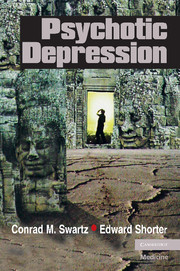Book contents
- Frontmatter
- Contents
- Preface
- Acknowledgments
- Chapter 1 Introduction
- Chapter 2 History of Psychotic Depression
- Chapter 3 Diagnosis in Psychotic Depression
- Chapter 4 Patients' Experience of Illness
- Chapter 5 Treatment in Historical Perspective
- Chapter 6 Treatment: Pitfalls and Pathways
- Chapter 7 Treatment: ECT, Medications, and More
- Chapter 8 Treatment by Type of Psychotic Depression
- Appendix 1 Summary Guide to Psychiatric Concepts
- Appendix 2 Summary Guide to Psychotropic Medication and Treatment
- References
- Index
Appendix 1 - Summary Guide to Psychiatric Concepts
Published online by Cambridge University Press: 10 September 2009
- Frontmatter
- Contents
- Preface
- Acknowledgments
- Chapter 1 Introduction
- Chapter 2 History of Psychotic Depression
- Chapter 3 Diagnosis in Psychotic Depression
- Chapter 4 Patients' Experience of Illness
- Chapter 5 Treatment in Historical Perspective
- Chapter 6 Treatment: Pitfalls and Pathways
- Chapter 7 Treatment: ECT, Medications, and More
- Chapter 8 Treatment by Type of Psychotic Depression
- Appendix 1 Summary Guide to Psychiatric Concepts
- Appendix 2 Summary Guide to Psychotropic Medication and Treatment
- References
- Index
Summary
For medication issues see Appendix 2: Summary Guide to Psychotropic Medication and Treatment.
History of illness and mental status examination
Much as in life, in medicine including psychiatry the understanding of the patient's complaint begins with listening to the history of the illness. Understanding the history often leads to the diagnosis.
The history of the present illness starts with understanding the dissatisfactions and complaints of the patient and family. Distinguishing between dissatisfaction and depression is important. The history identifies the very first onset of disturbances in behavior and speech and the time course of symptom disappearances and recurrences, hospitalizations, and medications.
The mental status examination is a description of the patient, perhaps similar to an observant character description in a book. It includes general appearance such as hygiene and amount of distress, attitude to the interviewer (helpful, passive, sarcastic), alertness, reliability, stated mood, observed emotional expression (affect), amount and peculiarities of muscle activity, rate and peculiarities of speech, basic intellectual function, peculiarities of expressed thoughts, and amount of insight. The study of these characteristics is called psychopathology.
Alertness is excessive in patients who are hypervigilant and hyperreactive. Progressively less alertness leads to somnolence (drowsiness), obtundation (decreased response), stupor (only slightly responsive), and coma. Diminished alertness is associated with catatonia or delirium.
The patient's mood is what he says it is. In contrast, affect is the nonverbal bodily expression of emotions, including rapport. A flat affect is mechanical. A labile affect changes rapidly.
- Type
- Chapter
- Information
- Psychotic Depression , pp. 263 - 268Publisher: Cambridge University PressPrint publication year: 2007



